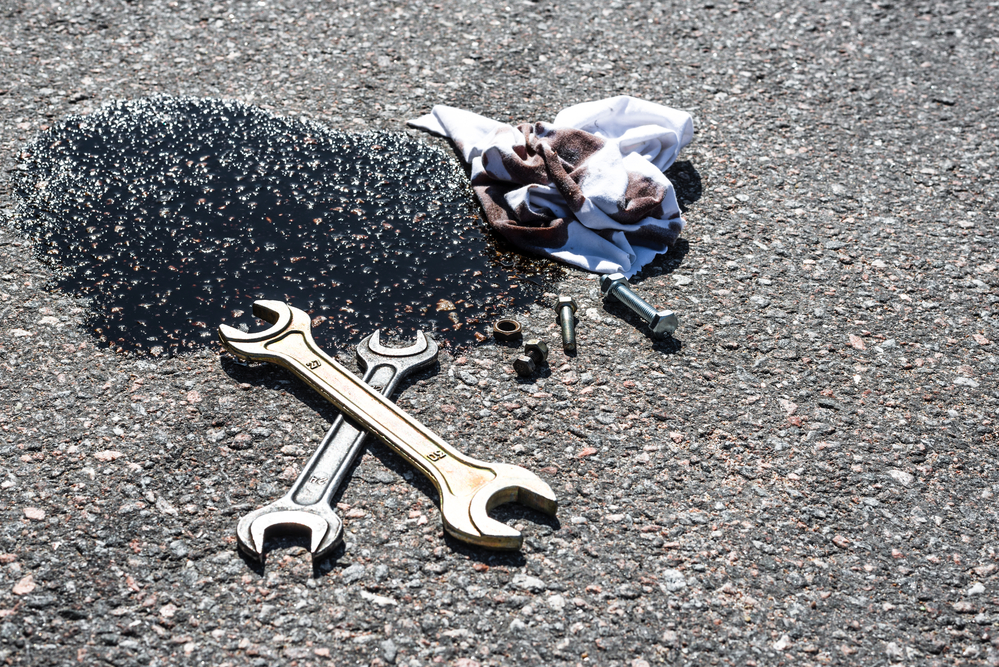When you park your car on a tarmac driveway it’s really only a matter of time until you suffer from an oil spill.
Spilled oil looks unsightly, of course, but there are other potential issues too. For example, liquid oil can be walked into your home causing damage to interior flooring. Lastly of course oil is also highly flammable, so can represent a very real danger to your property and your family.
Little wonder then that you’re here looking for how to remove oil from tarmac driveways.
Luckily, there are some proven ways to do just that, and get your tarmac driveway looking like new once again…
Use Cat Litter to Absorb Liquid Oil
Contents

First and foremost we need to draw a distinction between liquid oil that is sitting on the surface of your driveway, and long-dried oil spills that are really just a stain now. For liquid oil a good starting place is soaking up the fluid as quickly as possible.
Cat litter is possibly one of the best options here, due to its highly absorbent properties. Simply scatter generously over the spill, allow it to soak up the oil, then use a dustpan and brush to scrape the oily mess up and dispose of it appropriately and legally.
Of course, not all of us are cat owners, and time is of the essence so some other options are available. Other possibilities include sawdust, bark chippings or even old rags. The goal is to try and get the liquid oil up off the surface as quickly as possible so that it doesn’t have time to soak in.
Once the liquid is gone, now it’s time to tackle the staining. The process of removing an oil stain from a tarmac driveway is identical irrespective of how long it’s been there. The only real difference is that long-standing stains may need repeated treatment to fully get rid of the mark.
Here are some of the best options for removing oil stains from tarmac surfaces…
Professional Oil Stain Remover
There can be little doubt that the very best option of all is a professional oil stain remover. These powerful liquids actively break down the oil and render it non-flammable. They’re quite simply the most complete and effective answer to your problem.
Fortunately, they’re as easy to use as they are potent. While you should always follow the manufacturer’s guidelines carefully, the following should act as a rough guide for most stain removers:
Apply the liquid – Depending on the brand, some is applied neat while others need to be watered down. A solution that can be applied neat makes life a lot easier as it can be poured straight from the bottle onto the tarmac.
Agitate the surface – Next you need to work the liquid in, so that it can get to work. This normally entails scrubbing the stain with a stiff brush or broom.
Wait for the stain remover to work – Next you need to wait for the liquid to do its job. Generally you don’t want the liquid to dry out so pay particular attention in warm weather. Some of these oil stain removers are quite potent, so rather than heading inside to put your feet up, it’s generally better to stay closeby. That way you can ward off pets or visitors if necessary.
Wash away – Lastly once the time specified on the bottle has elapsed you’ll want to thoroughly wash the area to sweep away the oil and cleaner residue, while watering it all down. A power washer is the most effective solution here, but a standard garden hose may also be used if you’re willing to give it a good brush alongside.
And that’s it! Inspect the stain once the surface has dried to decide whether the tarmac needs a second treatment or not.
As a final note, be sure to select an oil stain remover that has been specifically designed to work on tarmac. Tarmac can be a funny surface and the wrong cleaner can do more harm than good.
Dish Soap
Typically less effective, but obviously cheaper, is dish soap. Squirt your washing-up liquid onto the stain, add a little water to create a froth, and brush it vigorously with a stiff broom. Rinse away once done and retreat the area as necessary.
Baking Soda
Another option is to sprinkle baking soda over the stain, add a small amount of water, and as with the dish soap work it into the tarmac surface well. Once again, rinse off after a few minutes and inspect the surface once dry.
Reseal the Surface
Tarmac driveways should be resealed from time to time. Doing so freshens the surface and puts essential resins back into your driveway to extend its lifespan. This can be particularly beneficial after an oil spill, where the cleaning process is at risk of removing some of these resins.
Sealing your tarmac driveway has another benefit too; it creates a new, attractive, uniform surface. In essence any residues from the oil spill will be hidden from view.
Depending on the severity of the spill, and the time since you last sealed your tarmac driveway, now may therefore be a perfect opportunity to consider investing in a can on sealer.
Conclusion
As you can see, with a little bit of effort you can banish stains from your tarmac driveway. Indeed, if you opt for a professional stain remover then you’ll find it requires minimal effort. Furthermore, a single bottle goes an awfully long way. So keep the remainder safe and sound so you’re ready for the next inevitable oil spill.
